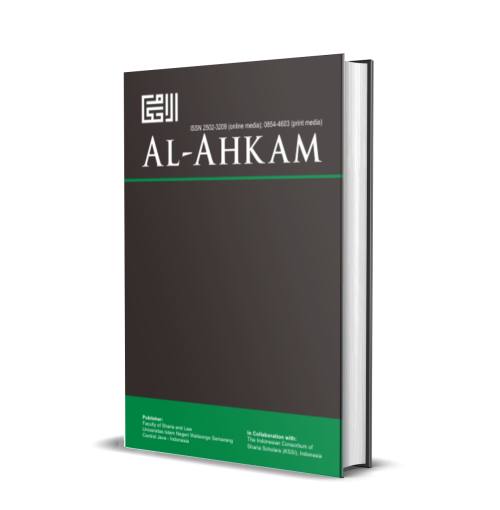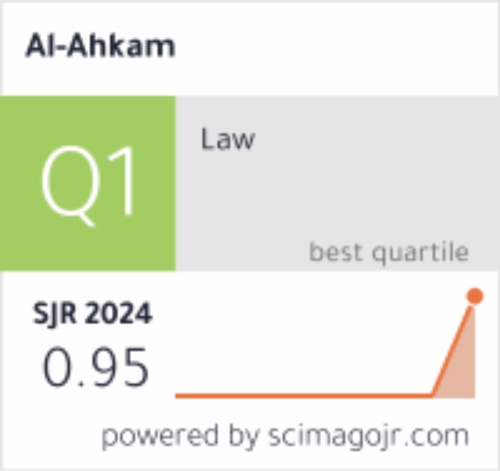Al-Ḥīlah al-Shar'iyyah as a Method in Responding to Prayer Problems in Space
DOI:
https://doi.org/10.21580/ahkam.2021.31.2.9004Keywords:
al-ḥīlah al-shar’iyyah, rukhṣah, prayer in space, Muslim astronautAbstract
This paper describes the prayer problem for Muslim astronauts in space and provides solutions using the al-ḥīlah al-shar'iyyah method. This paper is qualitative with descriptive-analytic research methods with data sourced from the literature. This paper finds that with the al-ḥīlah al-shar'iyyah method, Muslim astronauts can still carry out their obligations as a mukallaf. They get rukhṣah (dispensation), both related to the direction of the qibla and the determination of prayer times. Rukhṣah, as a result of the al-ḥīlah al-shar'iyyah method, helps Muslim astronauts in two conditions at once, first, in their position as scientists who carry out scientific missions. Second, in his position as a Muslim with his obligations to carry out the sharī'ah.
Downloads
References
‘A Brief History of Space Exploration’. Aerospace, 2018. https://aerospace.org/article/brief-history-space-exploration.
‘A Guideline of Performing Ibadah at the International Space Station (ISS)’, n.d. https://www.wired.com/images_blogs/wiredscience/files/a_guideline_ibadah_at_iss.doc#:~:text=Ibadah in this guideline include,caring of the deceased and.
Ahmad, Najib. ‘Analisis Penerapan Hilah Pada Fatwa Dewan Syariah Nasional – Majlis Ulama Indonesia (DSN MUI) tentang Murabahah Ijarah Muntahiyah Bi Al Tamlik (IMBT) dan Rahn’. Institute Agama Islam Negeri, 2020. http://repository.iainpurwokerto.ac.id/7023/.
Aibak, Kutbuddin, and Ahmad Munsonif. Metode Penentuan dan Akurasi Arah Kiblat Masjid-Masjid di Tulungagung. Tulungagung: IAIN Tulungagung Press, 2018.
Ash-Shiddieqy, T. M Hasbi. Pengantar Hukum Islam. Jakarta: Bulan Bintang, 1981.
Atjeh, Aboebakar. Ilmu Fiqh Islam dalam Lima Mazhab. Jakarta: Islamic Research Institute, 1977.
Belinda, Yohana. ‘Bikin Bangga, 11 Astronaut Muslim Ini Sukses ke Angkasa Luar’. Liputan 6, 2020.
Budi, Arifina. ‘Salat di Luar Angkasa’, 8 March 2017. https://tirto.id/salat-di-luar-angkasa-ckkQ.
Djazuli, A. Kaidah-Kaidah Fikih: Kaidah-Kaidah Hukum Islam dalam Menyelesaikan Masalah-Masalah yang Praktis. Jakarta: Kencana, 2001.
Fadhilah, Lutfi Nur. ‘Al-Ḥilah Al-Syar’iyyah dan Kemungkinan Penerapannya’. Elfalaky: Jurnal Ilmu Falak 3, no. 1 (2019). http://journal.uin-alauddin.ac.id/index.php/elfalaky/article/download/9778/6795.
Fischer, N. ‘Islamic Religious Practice in Outer Space’. ISIM Review 22, no. 1 (2008): 39–39. https://hdl.handle.net/1887/17252.
Hanafi, Imam. ‘Perkembangan Manusia dalam Tinjauan Psikologi dan Al-Qur’an’. IQ (Ilmu Al-Qur’an): Jurnal Pendidikan Islam 1, no. 01 (1 January 2018): 84–99. https://doi.org/10.37542/IQ.V1I01.7.
History.com Editors. ‘The Space Race’, 2020. https://www.history.com/topics/cold-war/space-race.
Jaelani, Achmad, Anisah Budiwati, Encep Abdul Rojak, Faqih Baidhawi, Mahya Laila, Hasna Tuddar Putri, Muhammad Manan Ma’nawi, et al. Hisab Rukyat Menghadap Kiblat (Fiqh, Aplikasi Praktis, Fatwa, dan Software). Edited by Ahmad Izzudin. 1st ed. Semarang: Pustaka Rizki Putra, 2012. http://eprints.walisongo.ac.id/id/eprint/6807/.
Kathir, Ibn. Tafsir Ibnu Kasir. Edited by Bahrun Abu Bakar. Bandung: Sinar Baru Algensindo, 2000.
Kristanti, Elin Yunita. ‘17-6-1985: Kisah Astronot Muslim Pertama di Luar Angkasa’. https://www.liputan6.com/global/read/2253350/17-6-1985-kisah-astronot-muslim-pertama-di-luar-angkasa.
Lewis, Cathleen S. ‘Muslims in Space : Observing Religious Rites in a New Environment’. Astropolitics 11, no. 1–2 (2013). https://doi.org/10.1080/14777622.2013.802622.
Mahsun, Mahsun. ‘Rekonstruksi Pemikiran Hukum Islam Melalui Integrasi Metode Klasik dengan Metode Saintifik Modern’. Al-Ahkam 25, no. 1 (25 April 2015): 1. https://doi.org/10.21580/ahkam.2015.1.25.191.
Marpaung, Watni. Pengantar Ilmu Falak. Jakarta: Prenadamedia Group, 2015.
‘Muslims in Outer Space’. Accessed 24 September 2021. https://rpl.hds.harvard.edu/religion-context/case-studies/technology/muslims-outer-space.
Ni’am, M. Ikhtirozun. ‘Arah Kiblat di Planet Mars’. Al-Marshad: Jurnal Astronomi Islam dan Ilmu-Ilmu Berkaitan 2, no. 1 (2016): 12–21. https://doi.org/http://dx.doi.org/10.30596%2Fjam.v2i1.762.
Potter, Sean. ‘NASA Astronauts to Answer Questions from STEM Students’, 2021. http://www.nasa.gov/press-release/nasa-astronauts-aboard-space-station-to-answer-questions-from-stem-students.
Rakhmadi, Arwin Juli. Pengantar Ilmu Falak: Teori, Praktik, Dan Fikih. 1st ed. Depok: PT. RAJAGRAFINDO PERSADA, 2019.
Ruhaeni, Neni, and Fariz Farikh Izadi. ‘The Outer Space Exploration Under International Space Law: An Islamic Point of View’. In 2nd Socia; and Humaniora Research Symposium (SoRes 2019), 409:369–72. Bandung: Atlantis Press SARL, 2020. https://doi.org/10.2991/assehr.k.200225.077.
Sarwat, Ahmad. Waktu Shalat. Edited by Fatih. Jakarta Selatan: Rumah Fiqih Publishing, 2018.
Shihab, M. Quraish. Tafsir Al-Misbah Pesan, Kesan, dan Keserasasian Al-Qur’an. Jakarta: Lentera Hati, 2001.
Takhim, Muhamad. ‘Metode Hilah (Dalih Hukum) dalam Fikih Muamalah Kontemporer’. Jurnal Sosio Dialektika Jurnal Ilmu Sosial-Humaniora 4, no. 2 (31 December 2019). https://doi.org/10.31942/SD.V4I2.3128.
The Editors of Encyclopaedia Britannica. ‘Sultan Ibn Salman Al Saud ’. Encyclopedia Britannica, 23 June 2021. https://www.britannica.com/biography/Sultan-ibn-Salman-Al-Saud.
Utama, Lazuardhi, and Misrohatun Hasanah. ‘Astronot Muslim Ternyata Bisa Salat dan Puasa di Luar Angkasa’, 12 May 2021. https://www.viva.co.id/digital/digilife/1372246-astronot-muslim-ternyata-bisa-salat-dan-puasa-di-luar-angkasa.
Yaqub, Ali Mustafa. Kiblat Antara Bangunan dan Arah Kakbah. Jakarta: Pustaka Darus-Sunnah, 2010.
Zamzami, Mukhtar. ‘Hiyal Asy-Syar’iyah dalam Praktek Hibah dan Wasiat’. Rakernas 2011 Mahkamah Agung dengan Pengadilan Seluruh Indonesia. Jakarta, September 2011. http://www.pa-lolak.go.id/images/hiyal_asy_syariyah_dalam_praktek_hibah_dan_wasiat.pdf.
Downloads
Published
How to Cite
Issue
Section
License
By submitting an article to the journal, the author(s) agree to transfer the published article's copyright to the journal, which will act as the publisher. This means the journal will have the right to publish the article in various forms, including reprints. The journal will maintain the publishing rights to the published articles.
In line with the license, authors and third parties (readers, researchers, and others) are allowed to share and adapt the material. In addition, the material must be given appropriate credit, provided with a link to the license, and indicated if changes were made. If authors remix, transform or build upon the material, authors must distribute their contributions under the same license as the original.




